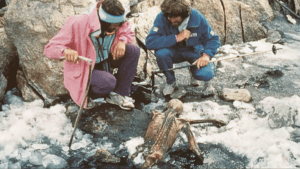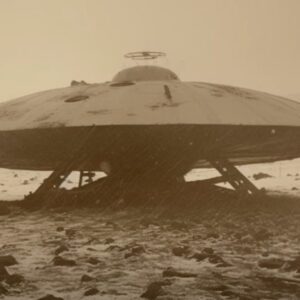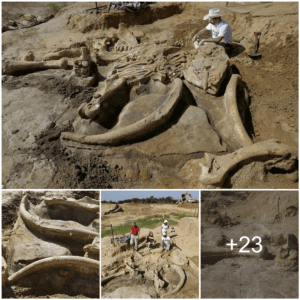In the frigid heights of the Austrian-Italian Alps, a staggering revelation from the depths of time has left scientists and evolutionists alike astounded. The perfectly preserved remains of Otzi the Iceman, a man frozen in ice for an astonishing 5,000 years, are rewriting the narrative of human evolution and challenging long-standing beliefs.
 Discovered by a German couple in 1991, Otzi’s well-preserved body, found at an altitude of 3,200 meters, stands as one of the most significant archaeological finds of the 20th century. However, what sets Otzi apart is not just his remarkably intact state but the wealth of artifacts surrounding him, providing unprecedented insights into his life during the Copper Age.
Discovered by a German couple in 1991, Otzi’s well-preserved body, found at an altitude of 3,200 meters, stands as one of the most significant archaeological finds of the 20th century. However, what sets Otzi apart is not just his remarkably intact state but the wealth of artifacts surrounding him, providing unprecedented insights into his life during the Copper Age.
As experts meticulously unraveled Otzi’s story, they uncovered a man who defied the expectations of his time. Dressed in carefully crafted attire, equipped with a sophisticated medical kit, fire-making tools, and an arsenal of weaponry, Otzi emerged as a highly advanced individual, challenging the notion that our ancestors were primitive beings.

The groundbreaking aspect of Otzi’s discovery lies in the recent DNA revelations that have sent shockwaves through the scientific community. The sequencing of Otzi’s genome, a decade-long endeavor, has provided a detailed map of his genetic makeup, offering insights into his physical appearance, health, and even his ancestry.
Contrary to prior assumptions, Otzi’s genome challenges the established image of his appearance. It turns out that this illustrious figure, whose legacy predates the Great Pyramids, likely had a bald scalp and darker skin than previously believed. Genetic predispositions to conditions like diabetes, obesity, and heart problems further add to the complexity of Otzi’s story.

One of the most intriguing aspects of the DNA revelations is Otzi’s connection to early Neolithic farmers. Specific gene changes in his genome link him to Anatolian farmers who migrated into Central Europe around 7000 BCE, challenging previous notions about the genetic makeup of ancient Europeans. The Alps, acting as a natural barrier, also reveal that Otzi’s community had limited interaction with neighboring populations.
Delving into the Biblical standpoint, Otzi’s existence challenges the conventional narrative of human evolution. His advanced lifestyle, marked by farming, herding, and metalworking, aligns with accounts in ancient texts like the Bible, challenging the notion that these practices evolved slowly over time.

In essence, Otzi the Iceman, frozen in time and emerging from the icy depths of the Alps, is not just a relic of the past. He is a disruptor of established beliefs, a messenger from an era where civilizations may have been more advanced than we ever imagined. As the scientific community grapples with these revelations, the story of Otzi invites us to rethink the trajectory of our own evolution.





